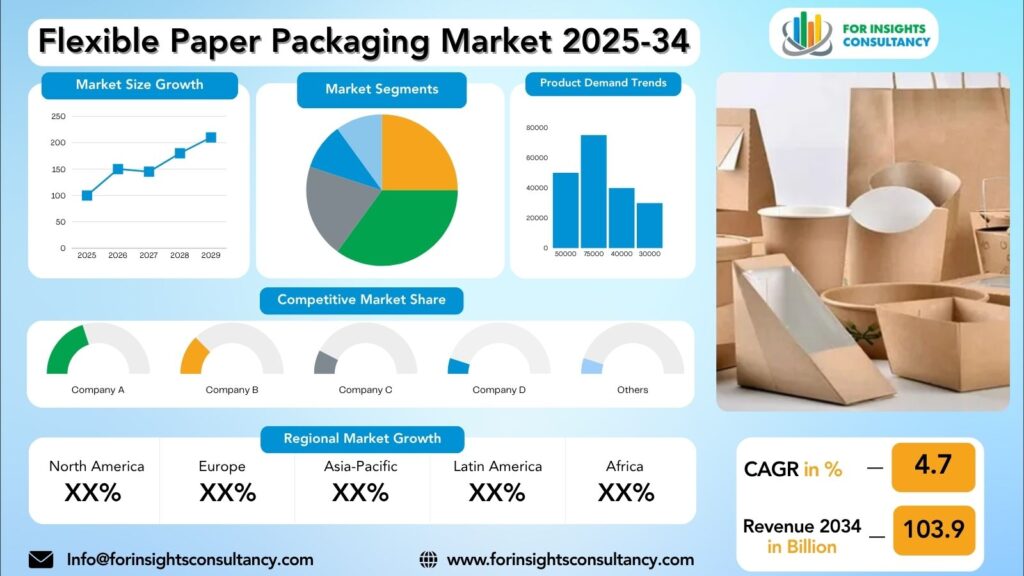
Flexible Paper Packaging Market Size, Trends Analysis Research Report By Packaging Type (Pouches (often the largest segment), Bags, Wraps, Roll Stock, Shrink Sleeves, and Envelopes), by Paper Grade (Material) (Kraft Paper (often the largest segment), Coated Paper, Laminated Paper, Parchment Paper, Greaseproof Paper, and Glassine Paper), by Printing Technology, by End-User Industry, and By Region Global Market Analysis And Forecast, 2025-2034
Oct-2025 Formats | PDF | Category: Packaging | Delivery: 24 to 72 Hours
The report highlights that the market outlook is significantly influenced by swift shifts in global trade relations and tariffs. It emphasizes the necessity of updating the report before delivery to incorporate the most current status, which includes revised market forecasts and a comprehensive analysis of the quantified impacts of these changes.
Flexible Paper Packaging Market Is Forecast to Increase from USD 75.8 Billion In 2025 To USD 103.9 Billion By 2034, At A CAGR Of 4.7%.
Flexible Paper Packaging Market: A Comprehensive Overview and Future Developments
flexible paper packaging market is growing, but it’s not a mystery why. It’s a direct response to a major market pressure: consumers and regulators are demanding sustainable alternatives to plastic.
This is driving the entire industry. Manufacturers aren’t just making minor tweaks; they’re in a race to develop truly innovative, high-performance paper-based materials that are every bit as strong, light, and effective as traditional plastic films.
The next phase of growth is all about making paper functional enough for even the toughest products. Expect to see significant breakthroughs in:
Barrier Technology: The biggest hurdle—handling moisture, air, and grease—is being overcome with new coatings. This will finally allow paper to move into demanding sectors like fresh produce, performance snacks, and convenience foods.
Design & Printing: New digital printing methods are allowing for incredibly detailed, vibrant designs. This means brands can use paper to build a much stronger, more visually appealing connection with shoppers on the shelf.
Ultimate Versatility: With its natural low weight and convenience, paper is rapidly becoming the standard for fast-moving markets like e-commerce and the “on-the-go” food sector.
Simply put, the market is perfectly positioned. As every business is tasked with finding solutions that are both practical for operations and responsible for the planet, paper is proving itself as the undeniable winner for a greener future.
Market Insights
- Asia Pacific holds the dominant revenue share, often cited athe 38% range in 2024, driven by a huge consumer base, rapid urbanization, and the booming e-commerce sector in countries like China and India.
- The Pouches segment is the dominant revenue generator in 2024. Pouches offer versatility across many industries.
- The Food & Beverage segment holds the clear majority market share (often cited around 59% in 2024)
- According to the latest data, the percentage of the U.S. population residing in urban areas in 2024 is estimated to be approximately 83.4%.
AI Impact
For years, flexible paper packaging was about printing and converting. Now? It’s a data game.
Here’s the real-world impact we’re experiencing:
Smarter Production, Less Waste
The days of simply guessing inventory or dealing with unexpected machine failures are fading. AI algorithms are now watching every stage of the production line.
Optimizing the Cut: AI analyzes material properties and complex packaging designs to figure out the absolute best way to cut the paper web, minimizing scrap and maximizing the number of pouches or bags from every roll. This translates directly into a massive reduction in production waste.
Predictive Maintenance: Instead of waiting for a printer or converting machine to break down, AI monitors vibrations, heat, and output quality to predict a fault before it happens. This keeps the lines running longer and more efficiently, slashing downtime.
Market Dynamics
Trends
The Relentless Green Push
This is the big one. Customers are no longer just aware of environmental issues; they’re demanding proof. The push for sustainable and eco-friendly packaging is now the price of entry.
It’s not enough to be just paper. Shoppers are actively hunting for products wrapped in packaging that is verifiably recyclable, truly compostable, and demonstrably made from renewable resources. This mandate from the public is forcing every player in the industry to ditch older materials and invest heavily in genuinely planet-friendly solutions.
Engineering Gets Clever
For a long time, flexible paper meant sacrificing functionality. Not anymore. The second major trend is the explosion of innovative packaging technologies that make paper perform like a powerhouse.
We’re seeing breakthroughs like ultra-lightweight paper materials that slash shipping costs, sophisticated advanced barrier coatings that keep products fresh just as well as plastic films, and convenient resealable features that consumers love. In short, paper is learning to be tougher, smarter, and more convenient than anyone thought possible a decade ago.
Growth Drivers
The Flexible Paper Packaging Market is currently experiencing significant growth driven by various factors. A notable catalyst is the increasing consumer demand for sustainable and environmentally friendly packaging solutions. As consumers become more aware of the ecological implications of packaging materials, there is a marked shift towards paper-based alternatives. Furthermore, changes in the regulatory environment and government incentives aimed at encouraging the use of recyclable materials are facilitating the adoption of flexible paper packaging. Companies are actively investing in eco-friendly packaging initiatives to align with these regulations and satisfy consumer preferences.
In addition, the surge in e-commerce and online shopping is contributing to the heightened demand for flexible paper packaging. As the volume of products being shipped and delivered rises, there is an increasing need for packaging that is lightweight, durable, and cost-effective. This growing requirement is significantly propelling the market forward, as businesses seek innovative solutions to meet the evolving demands of both consumers and regulatory frameworks.
Restraints
Restraints impacting the flexible paper packaging market include several interrelated challenges. Firstly, maintaining the structural integrity of paper packaging while ensuring its flexibility is a significant hurdle. This requirement necessitates an innovative approach to balance performance with sustainability, as both environmental considerations and functional requirements must be addressed. Another major restraint is the inherent limitation in barrier properties of paper compared to traditional plastic packaging. This less effective barrier can adversely affect the shelf life and protection of products, hampering their market viability. Furthermore, the costs related to the development of new paper-based packaging solutions can be prohibitive, posing another obstacle to the growth of this market segment. The potential resistance from consumers who are accustomed to conventional packaging materials further complicates the adoption of flexible paper packaging, making it essential for manufacturers to find effective strategies to overcome these challenges in order to succeed. Overall, the interplay of structural, economic, and consumer behavior factors creates a complex environment for the flexible paper packaging industry.
Opportunities
The Flexible Paper Packaging Market is experiencing notable growth, presenting numerous opportunities for businesses in the sector. A predominant trend is the increasing demand for sustainable and eco-friendly packaging solutions, with paper packaging emerging as a top choice for environmentally conscious consumers. This demand for biodegradable options allows companies to leverage growing consumer preference towards sustainability. Furthermore, the versatility of flexible paper packaging enables innovative designs and customization, accommodating the specific needs of various products and brands. This adaptability not only aids in product differentiation but also enhances branding strategies, allowing companies to distinguish themselves in a competitive landscape. Additionally, the booming e-commerce sector is escalating the need for lightweight and durable packaging solutions; flexible paper packaging stands out as a practical and cost-effective alternative for businesses aiming to streamline their supply chain and distribution processes. By embracing these opportunities, companies can foster growth and achieve success in the continually evolving packaging industry.
Challenges
Some of the primary challenges encountered by the Flexible Paper Packaging Market arise from the competitive landscape and inherent material limitations. The market faces stiff competition from alternative packaging materials, particularly plastics and metals, which possess distinct properties and functionalities that can outperform paper in certain applications. A significant concern for flexible paper packaging is its limited barrier properties; this limitation can impact the protection of sensitive products from external factors such as moisture, oxygen, and light, potentially compromising product integrity. Furthermore, while paper is often viewed as a more environmentally friendly option, its recyclability and sustainability are jeopardized by the use of chemical treatments and coatings intended to enhance performance. Such treatments raise environmental concerns, indicating a trade-off between performance and ecological impact. Therefore, industry players must navigate the complex landscape of meeting diverse packaging requirements across various sectors, balancing cost-effectiveness with environmental sustainability—an ongoing challenge that shapes the future of flexible paper packaging.
Flexible Paper Packaging Market Top Companies Covered In This Report:
Evaluate The Strategic Positioning And Innovation Pipelines Of Leading Market Companies-From Multinational Enterprises To Disruptive Regional Firms. Understand How Key Players Are Innovating, Expanding, And Capturing Value, And Use Competitive Benchmarks To Plan Your Next Move.
- Smurfit Kappa
- Amcor Limited
- Mondi Group
- Sonoco Products Company
- Sealed Air Corporation
- Huhtamaki OYJ
- Sappi Global
- DS Smith
- Coveris Holding SA
- Sabert
- Wihuri
Flexible Paper Packaging Market Company News 2024 and 2025
Mondi Group
Major Product Launches & Partnerships: Launched FunctionalBarrier Paper Ultimate (an ultra-high barrier paper solution for dry foods like coffee and spices, eliminating multi-layer plastic). Partnered with companies (e.g., Proquimia, Astrabio) to launch paper-based stand-up pouches for dishwasher tabs and pasta, demonstrating real-world applications. Introduced the re/cycle Protective Mailer to replace plastic bubble wrap for e-commerce. Focused on displaying a wide range of barrier papers and recyclable fiber-based solutions at major industry events (e.g., Fachpack 2025).
Smurfit Kappa
Market Consolidation & Sustainability Investment: Completed the major strategic combination with WestRock in July 2024, creating “Smurfit Westrock,” a global leader with vast capacity in paperboard and packaging solutions. Acquired a Bag-in-Box plant in Bulgaria (Feb 2024), enhancing their capabilities in flexible liquid packaging (films, bags, and boxes). Continues to focus on their Bag-in-Box and Pouch-Up solutions, which often use paperboard in conjunction with flexible inner bags.
Amcor plc
Technology & Barrier Solutions: Continues to advance its AmFiber™ portfolio, which includes high-barrier paper-based packaging designed for recycling, targeting sectors like snacks and confectionery. Showcasing AI vision technology integration into packaging equipment (IPPE 2025), with systems that scan products and dispense customized bag sizes, focusing on waste reduction and efficiency. Investing in smart, automated packaging solutions to enhance sustainability and productivity for customers.
Segmented View of The Industry:
The Flexible Paper Packaging Market Is Mapped Through A Multidimensional Lens-Tracking Shifts Across Product Type, Applications, And Geographic Regions. This Segmented Approach Enables Businesses to Localize Their Growth Plans And Align Offerings With The Most Profitable Demand Centres.
Segmentation By Packaging Type
- Pouches (often the largest segment)
- Bags
- Wraps
- Roll Stock
- Shrink Sleeves and Envelopes
Segmentation ByPaper Grade (Material)
- Kraft Paper (often the largest segment)
- Coated Paper
- Laminated Paper
- Parchment Paper
- Greaseproof Paper
- Glassine Paper
Segmentation ByEnd-User Industry
- Food & Beverage (often the largest segment)
- Healthcare & Pharmaceuticals
- Beauty & Personal Care
- Home Care
- Pet Food
Global Geographic Coverage:
The Report Provides In-Depth Qualitative And Quantitative Data On The Flexible Paper Packaging Market For All Of The Regions And Countries Listed Below:
North America
The flexible paper packaging market in North America is anticipated to witness consistent growth, buoyed by the region’s stable GDP growth and low inflation rates. In the United States, a notable government subsidy promoting eco-friendly packaging materials acts as a critical catalyst for the success of these products. E-commerce platforms are identified as the primary distribution channel for flexible paper packaging, whereas specialty retail stores that focus on environmentally conscious consumers represent the fastest-growing segment. Consumer demand in North America increasingly prioritizes sustainability and ethical sourcing, alongside a notable shift towards localism. In contrast, emerging markets where price and status are pivotal, brands must balance competitive pricing with alignment to consumer values to thrive.
Europe
In the European flexible paper packaging market, steady GDP growth is anticipated alongside an inflation rate of approximately 2%. A significant and non-replicable factor driving this market is the stringent sustainability regulations in Germany, which are focused on promoting eco-friendly packaging solutions. The primary distribution channel for flexible paper packaging remains retail supermarkets, but e-commerce is emerging as the fastest-growing channel, a shift fueled by the increasing trend of online shopping.
European consumers are progressively demanding greater sustainability and ethical sourcing in the products they purchase, necessitating that companies emphasize these attributes in their offerings. While price and status continue to influence consumer preferences in various emerging European markets, there is a notable shift towards valuing sustainable and locally sourced products. Consequently, firms in the flexible paper packaging industry must adapt to these evolving consumer preferences to maintain competitiveness in the marketplace.
Asia Pacific
The Flexible Paper Packaging market in the Asia Pacific region is poised for substantial growth, largely fueled by a robust economy predicted to expand at a GDP rate of 6% alongside a stable inflation rate of 2%. Notably, in Indonesia, government initiatives promoting eco-friendly packaging have significantly elevated the demand for sustainable paper packaging solutions, which have become crucial in influencing consumer purchasing behavior. The retail sector emerges as the dominant channel for Flexible Paper Packaging, while e-commerce is recognized as the fastest-growing channel, driven by the surge in online shopping habits among consumers.
In more environmentally conscious nations such as Japan and South Korea, sustainability and ethical sourcing are essential considerations for consumers, reflecting a high level of environmental awareness. Contrastingly, in several emerging markets, consumer preferences lean towards affordability and status, leading to a demand for products that strike a balance between cost-effectiveness and quality. This dichotomy highlights the diverse market dynamics within the region, where varying consumer priorities influence purchasing decisions and the overall direction of the Flexible Paper Packaging market.
Middle East and Africa
The Flexible Paper Packaging Market in the Middle East and Africa is projected to experience significant growth driven by the region’s increasing GDP and moderate inflation rate. In the Middle East, the local driver impacting the market is the rising popularity of eco-friendly products due to growing environmental awareness, particularly in countries like the UAE where sustainability is a must-have for consumers. The dominant channel for flexible paper packaging is supermarkets, while e-commerce is the fastest-growing channel in the region. Ethical sourcing and sustainability are key factors influencing consumer preferences, with a focus on reducing environmental impact. In many emerging markets in the region, price and status still dominate consumer decisions, but there is a growing trend towards conscious consumption.
Reasons To Buy:
- The Research Would Help Top Administration/Policymakers/Professionals/Product Advancements/Sales Managers And Stakeholders In This Market In The Following Ways.
- The Report Provides Flexible Paper Packaging Market Revenues At The Worldwide, Regional, And Country Levels With A Complete Analysis To 2034 Permitting Companies To Analyze Their Market Share And Analyze Projections, And Find New Markets To Aim For.
- To Understand The Most Affecting Driving And Restraining Forces In The Market And Their Impact On The Global Market.
- Major Changes And Assessment In Market Dynamics And Developments.
- The Objective Of The Flexible Paper Packaging Market Report Is To Identify New Business Opportunities Using Quantitative Market Forecasts.
- Formulate Sales And Marketing Strategies By Gaining An Understanding Of Competitors, Their Positioning, And Strengths & Weaknesses.
Faq – What Global Leaders Are Asking
What Is The Growth Prospect For The Flexible Paper Packaging Market By 2034?
Flexible Paper Packaging Market Is Expected To Achieve A Stable Growth Rate With A Compound Annual Growth Rate (CAGR) Of About 4.7% From 2025 Through 2034.
What Is Driving The Growth Of The Flexible Paper Packaging Market?
The market growth is primarily driven by surging consumer demand for sustainable, recyclable, and biodegradable solutions, coupled with stringent government regulations against single-use plastics.
Who Are The Key Players In The Flexible Paper Packaging Market, And What Are Their Market Shares?
The Flexible Paper Packaging Market Includes Major Companies Amcor Limited (Australia), Mondi Group (UK), Sonoco Products Company (US), Sealed Air Corporation (US), Huhtamaki OYJ (Finland), Sappi Global (South Africa), DS Smith (UK), Coveris Holding SA (UK), Sabert (US), Wihuri (Finland), Others.
Specific Market Share Data Is Not Publicly Available And Is Typically Provided In Detailed, Proprietary Market Research Reports.
Which Regions Are Leading The Flexible Paper Packaging Market Growth?
Asia Pacific currently dominates the market share and is expected to be the fastest-growing region, driven by rapid e-commerce growth and shifting consumer preference toward sustainable options.
Customized Report as per your Business Needs
- Our analysts will work directly with you and understand your needs
- Get data on specified regions or segments, competitor and Vendors
- Data will be formatted and presented as per your requirements
Any Requirement Contact Us: Https://Www.Forinsightsconsultancy.Com/Contact-Us/
Table of Contents
For TOC Contact us: https://forinsightsconsultancy.com/contact-us/







